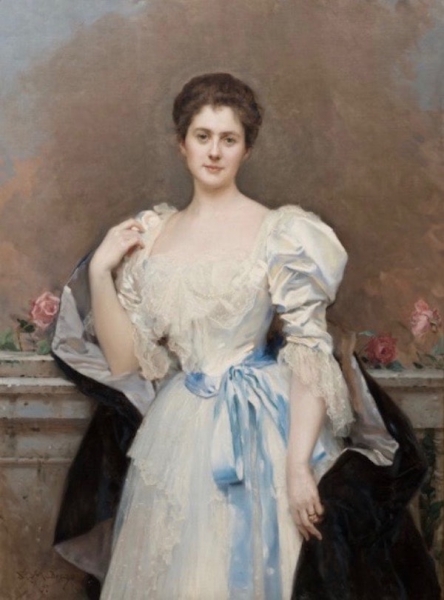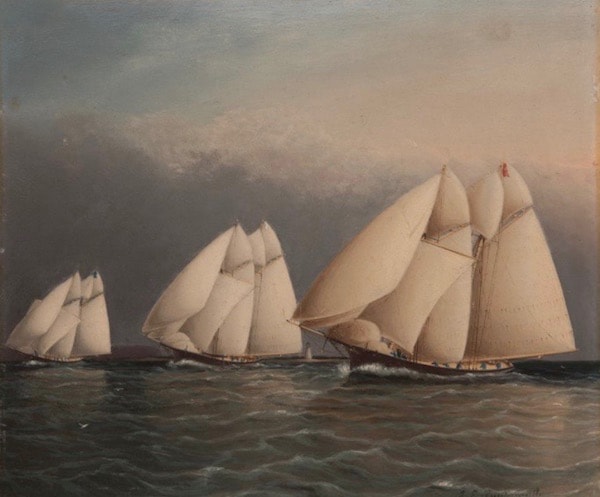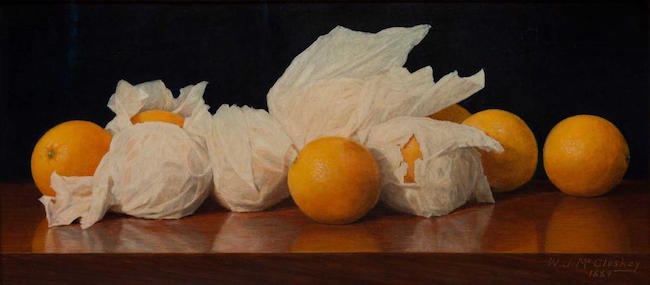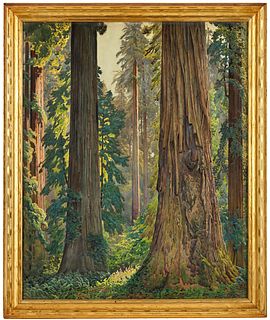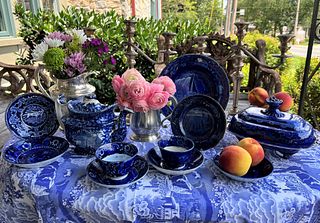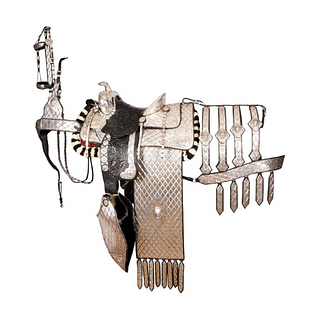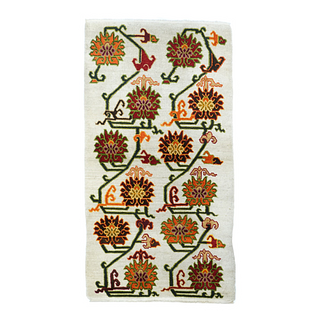The Technology of Technique
As pixels continue to expand within our pocket sized devices, the potential for photographic opportunity has doubtlessly peeked. Gone are the days when people can be heard exclaiming "Oh, nobody brought a camera!" a sentiment lost when sacred, fleeting moments used to dance away from us in the form of epic sunrises and cake-faced birthday moments. The rapid consumption of personalized cinema is even more apparent in portraiture, where sitter and artist are now often one in the same.
On June 11th, Grogan & Company, Fine Art and Jewelry Auctioneers, will present their June Auction. The sale will open with a selection of fine artworks to highlight 19th and early 20th-century painters within the marine genre, portraiture, still life and landscape. Followed by nearly 200 lots of jewelry as well as silver goods, modern sculptures, ceramics, works on paper, decorative arts, furniture and Oriental rugs.
Whether we are taking selfies in the living room or posting our perfectly plated eggs, the purpose and impact of an image has surely been desensitized. However, it wasn’t that long ago when the mastery of a painters palette meant becoming a supreme captor of life. The following selection is a testament to the long ago technology of technique, before changing ones "social status" was as easy as proclaiming it on Facebook.
Those that did manage to grasp their way to the upper echelons of society, basked in baroque activities that solidified their fortunate stations. In 19th-century America, especially New York City, portrait sitting was a noble trend that mimicked European class distinctions and employed those with the tools of the trade.
The symbiotic relationship between patron and artist was haistly harvested in New York City with the arrival of new money; successful investors, financiers, traders, politicians - and their wives. Lot 18, Raimundo De Madrazo y Garreta, Portrait of Mrs. Oliver Gould Jennings, Oil on canvas, 1897 - is a pristine example of a commissioned work from this period. The Spanish painter, Raimundo De Madrazo y Garreta, was well known for his flirtatious genre scenes, depicting Masquerades and kittenish women. His skills were popularly noticed during his lifetime and attracted top tier clients such as the Vanderbilt family, J.P. Morgan and Alexander Turney Stewart. To be painted in the same light, by the same set of brushes as New Yorks elite class was as valuable for the patron as it was for the artist. Mrs. Oliver Gould Jennings was no exception, having married one year prior to the painting of this portrait to Mr. Oliver Gould Jennings an heir to the Standard Oil company and head of many profitable businesses.
Youth and timeless flattery is the dominant force behind this neutral composition. Besides the bright blue ribbon falling at her waist, this bride is enveloped in an earth-toned narrative that elegantly decants wealth into divinity. This portrait is a regal representation of Madrazo’s realist style, casting fantasy aside to communicate that this woman lived a real life of American aristocracy.
Without the convience of satellites revolving around the Earth to photograph and track these racing yachts, enthusiastic maritime artists hook our imaginations in their salt spritzed canvases. The active works of James Edward Buttersworth are celebrated as widely as the oceans that they depict in his wind gusted chronicles of racing sailboats in both English and American yachting competitions.
In this particular scene, Lot 6, James Edward Buttersworth, The Start of the Great Transatlantic Yacht Race, Oil on board - the blue, white and red flags coorelate with three ships known to have finished this particular race. According to R.J. Schaefer in his book J.E. Buttersworth, 19th Century Marine Painter, the three schooners in this work are identified as "...Henrietta, owner James Gordon Bennett; Vesta, owner Pierre Lorillard, and Fleetwing, owner George and Franklin Osgood. For purposes of easier identification, they flew their assigned colors of blue, white, and red, respectively. Henrietta was first to finish off the Needles, Isle of Wight on Christmas Day in the time of 13 days, 21 hours, and 45 minutes. The other two schooners finished by 9 hours and 5 minutes later, and within 40 minutes of each other.
Although, the Transatlantic race is still hosted and conqured, it is impressive to imagine the first few groups of gentlemen who braved the elements by casting wood, rope, sail and spirit into the unpredictable blue.
Lot 21, William Joseph McCloskey, Valencia Oranges, Oil on canvas, 1889; Estimate $80,000 - $150,000
I suppose you can say that food imagery is back in style! Except, William Joesph McCloskey was not simply showing off the citrus he scored at the organic farmers market.
As his best known subject matter, still lives of fruit in the tromp loeil style (the illusion of dimension) this painting of scattered Valencia Oranges is plucked right off the branch of McCloskeys most revered renderings. With the reflective, shallow, mahogany edge so near and the infinitely dark background so vacant, the bright flesh of the oranges seem to effortlessly rest and glisten in space. In a juxtaposition of textures and in a slightly triangular forming manner, the waxy white tissue wrappings add a personal flare to what would otherwise be a standard still life. McCloskeys inclusion of the wrapping reminds the viewer that these fruits are delicately transported and exposes a gift-like quality to the paintings laborious beauty.
Painted in 1889, Valencia Oragnes was displayed in the First Fine Arts Exhibition of the Detroit International Fair that same year, and is accompanied by a copy of the fairs exhibtion catalouge.
Its a wonder how, given our 21st-century advancements, people tend to congregate around similar genres of imagery. Being that photography is now accessible to the masses, our ideals of beauty havent drastically changed. Elegant imagery of wild herbs and sliced fruits gain as much praise as they did in McCloskeys day. A single sailboat crossing an electric pink horizon is all we need to go reaching for our phones (desperately testing the zoom feature). Multi-filtered selfies are held on a pedestal and deemed worthy of being ones "profile picture" - not dissimilar to the oil painted "calling cards" that were framed in gild and hung in wealthy halls.
Browse the full catalog by clicking here: Grogan & Company, Fine Art and Jewelry Auctioneers, will present their June Auction on June 11th.
- Rafael Osona Auctions' Modern & 19th Century Design From Nantucket Estates
- Quilts as a 2025 Design Trend: A Celebration of American Heritage and Craftsmanship
- A Celebration of Sports History and Collectibles
- The Thrill of Sports Memorabilia Auctions: A Collector’s Paradise
- Demystifying Coin Condition: A Guide to the Sheldon Grading Scale
- Snoopy & Friends: A “Peanuts” Auction at Revere
- Colorful Chinese Monochromes at Millea Bros
- 12 Holiday Gifts for the “Impossible to Buy For” on Bidsquare
- Alluring Art Objects and Accessories from the Estate of Chara Schreyer
- Kimball Sterling's One-Owner Outsider and Folk Art Collection Showcases Masters of the Unconventional



 EUR
EUR CAD
CAD AUD
AUD GBP
GBP MXN
MXN HKD
HKD CNY
CNY MYR
MYR SEK
SEK SGD
SGD CHF
CHF THB
THB